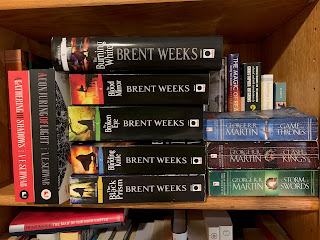Back in the spring when many of us were in full quarantine, there was chatter in various periodicals and on social media about reading: whether people can focus on a book or not; if they are reading, how much; have their reading tastes changed; what are they looking for at the moment. The Washington Post even tried to help you identify what type of quarantine reader you might be.
Pre-pandemic--last Thanksgiving in fact--I started N.K. Jemisin's Broken Earth trilogy and finished it this past February. It's been a long time since I finished a series. And it felt great. There's a sense of comfort when starting a new book in a world and with a set of characters you already know.
Previously, I've read Margaret Atwood's Oryx and Crake trilogy, The Hunger Games, The Girl with the Dragon Tattoo, and the Dead is Better series (thanks for the rec, Nicki!). But that's been over the past 15 some odd years. That's it. Thinking back, my childhood was stuffed with the ubiquitous kids' series. In my case, there were the series for horse-crazy girls like the Thoroughbred series, The Saddle Club series, and the Animal Inn series. But as I reminisce, I realize I never finished any of these series. They were more like those TV show syndicates: you pick up the same ones from the library but you never reach the end.

Now I find myself thirsting for comfort and escape and lookee here, SFF to the rescue (as usual, right?). I purchased V.E. Schwab's Shades of Magic series after drooling over it at my local indie book shop Curious Iguana for the past few years and now that Brent Weeks has finished the fifth and final installment of his Lightbringer series, yep, that's on the list this year, too. In prep for the movie release this fall, it's time to re-read Dune and, what the hell, dive into the rest of that series too. Oh, and the Hitchhikers' Guide series. And I picked up the first three installments of Game of Thrones from a local little free library last winter so . . .
Whew, that's a lot of series. Quite a shift from my "normal" reading but as it feels like lately with everything else, what's normal? I demand escape and comfort. And I'm finding it (as usual, right?) in books. Are there any other series out there I'm missing? What are you reading lately?



















